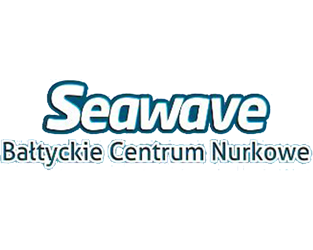 I spent more than half my adult life on the water, I was met with many adventures, more or less exciting. There were hardware failures, extreme weather and many more, all this has taught me humility and that everything can happen at the wrong time. With a clear conscience, however, I can admit that tourism on the waters of inland is a great pleasure, communing with nature, with nature, peace and quiet. And it does not matter whether we swim on lakes, canals or rivers and whether we sail on sailing yachts, motor yachts or housebots. Everyone will remember such a cruise as an adventure of life. However, to make this adventure only good, one should always remember about the principles prevailing on the water, Common sense, humility for the wind and water and a few simple rules will cause that we will gladly return to the water. This tab is for everyone, for those who start their adventure with water as well as those more experienced who have many water adventures behind them. It should help you safely spend your holidays on the water.
I spent more than half my adult life on the water, I was met with many adventures, more or less exciting. There were hardware failures, extreme weather and many more, all this has taught me humility and that everything can happen at the wrong time. With a clear conscience, however, I can admit that tourism on the waters of inland is a great pleasure, communing with nature, with nature, peace and quiet. And it does not matter whether we swim on lakes, canals or rivers and whether we sail on sailing yachts, motor yachts or housebots. Everyone will remember such a cruise as an adventure of life. However, to make this adventure only good, one should always remember about the principles prevailing on the water, Common sense, humility for the wind and water and a few simple rules will cause that we will gladly return to the water. This tab is for everyone, for those who start their adventure with water as well as those more experienced who have many water adventures behind them. It should help you safely spend your holidays on the water.
The first thing you should remember is the WOPR emergency number
601 100 100
If you are a witness to a dangerous event on the water or you participate in it yourself, do not hesitate, call them.
WATCH DECALOG
1. The cruise route. Plan a cruise with all details, daily flights, replenishment of supplies, bridge working hours, slipways, sluices, parking places, etc. Let your relatives know about them.
2. Communication. Have a cell phone with you. Always in a waterproof case. Remember the emergency number WOPR 601 100 100
3. Weather. Before the cruise, check the weather forecasts, if possible check them during it, observe the sky and water. Do not underestimate any signs of a bad weather.
4. Safety on the yacht. Keep life vests in an easily accessible place. In the wind above 3B (4/5 m / s, 16 km / h) a vest should be worn regardless of swimming skills. Children and non-swimmers should wear vests during the cruise as well as in ports. Use the rule one hand for yourself, one for the yacht. Do not leave children unattended.
5. Maneuvering in ports. Do not push yourself into the "big room", consider the size of the yacht and choose the safest place, not the nearest to the toilet. During maneuvers, use nature: wind and electricity. Try to moor against the wind or electricity. Anchoring only against the wind.
6. Help others. No matter in port or on the water, always try to help other water sportsmen, you do not know when such help will be needed by you.
7. Environment. Get strong trash bags and throw them in designated places. Do not pour washings with chemicals into the water. Do not allow fuel and engine oils to leak. Empty chemical toilet and faecal tanks only in designated places. We all want to enjoy pure nature for as long as possible.
8. Respect nature. Do not shoot to the shores, breaking through the coastal vegetation, choose wild places for stopovers in the wild. Do not destroy aquatic and terrestrial vegetation. Swim in the middle of a river devoid of plants. Only make bonfires in permitted places. Leave order.
9. Look after the yacht. Take care of the cleanliness of your unit inside and outside, sensitize the crew. Do not use any chemicals for washing the yacht, ordinary water and a rice brush. The yacht on which you sail is your visiting card.
10. Common sense. It is useful not only in everyday life, especially needed on the water. Have humbleness for water and wind.
General note! The Vistula Lagoon is sea internal waters, intended for experienced water sportsmen. Crews without experience will feel safer on the rivers of the Żuławy Loop or the Elbląg Canal and its lakes. Vigilance and common sense must be observed in all waters.
CAPTAIN'S ADVICES
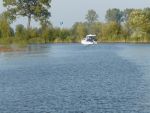 Sailing a motor yacht is not more complicated than driving a car or a motorcycle, but remember a few things. No brake (braked by the engine), weight and hence, high inertia (it takes a while before the boat will accelerate and stop), susceptibility to wind and current. Our yachts are powered by trailer engines, so we control the engine (there is no typical rudder blade), the tilting of the engine with the screw causes the yacht to turn. Engine idling causes loss of steering, but on the reverse we have almost full maneuverability. We have installed towing screws, thanks to which yachts have a lower maximum speed but more power. That's what we wanted to get, we're finally in no hurry, and the maneuvers of a few-ton unit are easier. Engines with pulling bolts have the best operating characteristics when we use about 80% of power (the best ratio of combustion to the obtained effect), so let's try to swim this way during normal operation. Bow thrusters mounted on the bows of our yachts definitely facilitate maneuvers. It is only necessary to remember that the higher the speed, the lower the efficiency of the thruster. They are only used for port maneuvers.
Sailing a motor yacht is not more complicated than driving a car or a motorcycle, but remember a few things. No brake (braked by the engine), weight and hence, high inertia (it takes a while before the boat will accelerate and stop), susceptibility to wind and current. Our yachts are powered by trailer engines, so we control the engine (there is no typical rudder blade), the tilting of the engine with the screw causes the yacht to turn. Engine idling causes loss of steering, but on the reverse we have almost full maneuverability. We have installed towing screws, thanks to which yachts have a lower maximum speed but more power. That's what we wanted to get, we're finally in no hurry, and the maneuvers of a few-ton unit are easier. Engines with pulling bolts have the best operating characteristics when we use about 80% of power (the best ratio of combustion to the obtained effect), so let's try to swim this way during normal operation. Bow thrusters mounted on the bows of our yachts definitely facilitate maneuvers. It is only necessary to remember that the higher the speed, the lower the efficiency of the thruster. They are only used for port maneuvers.
PORT MANEUVERING
 In most marinas, due to the large occupancy and designs of piers, we moor with a bow or stern, the other end of the yacht stands on a buoy or anchor. How many waterers have so many opinions, which method is more practical, both have their pros and cons. When approaching to the berth, try to expose the smallest possible surface of the yacht to the wind. In river marinas, we are mooring with a side, which, it is the skipper's decision, remember only that it is much easier to wind and / or electricity, and even necessary on the Vistula.
In most marinas, due to the large occupancy and designs of piers, we moor with a bow or stern, the other end of the yacht stands on a buoy or anchor. How many waterers have so many opinions, which method is more practical, both have their pros and cons. When approaching to the berth, try to expose the smallest possible surface of the yacht to the wind. In river marinas, we are mooring with a side, which, it is the skipper's decision, remember only that it is much easier to wind and / or electricity, and even necessary on the Vistula.
All port maneuvers, locks, etc. must be planned in advance (always prepare plan B), discussed with the crew (everyone needs to know what to do). We enter the port with a minimum control speed, prepared moorings, bouncers and anchor, the crew should already be at the skipper's designated locations, and its commands should be short, concise and understandable. Under no circumstances do we jump with a rope (it is better to shout, ask someone to pick us up), do not restrain with a leg, barefoot or other part of the body (always a motor). When leaving the port proceed in the same way, make sure that we have enough supplies for the trip, especially fuel, and whether everything that is to be operational is in working order.
IN KANAL
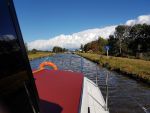 Sailing in a canal is nothing more than operating on a limited water. The yacht will behave a little differently than on open water areas. In the canal, especially Elbląski and Iławski, the depth is limited (the deepest depth is in the center of the canal and out towards the banks) and width, the speed should be adapted to the conditions encountered so that we have time to react and correct the course. Meeting another yacht in the canal is not a terrible thing, but requires focus and attention. Passing as port maneuvers, slow down and even approach the shore and wait for another yacht or ship Nas to pass.
Sailing in a canal is nothing more than operating on a limited water. The yacht will behave a little differently than on open water areas. In the canal, especially Elbląski and Iławski, the depth is limited (the deepest depth is in the center of the canal and out towards the banks) and width, the speed should be adapted to the conditions encountered so that we have time to react and correct the course. Meeting another yacht in the canal is not a terrible thing, but requires focus and attention. Passing as port maneuvers, slow down and even approach the shore and wait for another yacht or ship Nas to pass.
It is better to wait for the open water with anticipation, the more so as we are on holiday and we are not in a hurry anywhere. However, if we decide, remember that the overtaking maneuver is a more dangerous maneuver, due to the duration of the maneuver and the forces that affect both boats.
The canal is overgrown with aquatic vegetation and floating islands, which often form on long sections of "suppositories" through which it is necessary to pierce, with anxiety controlling the screw (when necessary, the screw should be cleaned, we do it only on a stopped engine and preferably with skidding in pocket) and the cooling system of our engine. The most vegetation on the Canal is in the vicinity of the slipway and on the sections between them.
ON VISTULA RIVER
 We sail on the Lower Vistula River as it is on a regulated river, from one bank to the opposite bank, then along the shore (from several hundred meters to several kilometers, to the next signs and to the opposite side). due to dangerous regulation spurs. Carefully read the water and analyze its disturbances. The lower section of the Vistula requires boundary signage. At low water levels, sail according to the signs is absolutely necessary! The edge mark ends at 928 km - before the bridge in Kiezmark. From that moment, you can swim the entire width of the river, of course, being careful. The kilometer marks on the white boards appear irregularly on the edges.
We sail on the Lower Vistula River as it is on a regulated river, from one bank to the opposite bank, then along the shore (from several hundred meters to several kilometers, to the next signs and to the opposite side). due to dangerous regulation spurs. Carefully read the water and analyze its disturbances. The lower section of the Vistula requires boundary signage. At low water levels, sail according to the signs is absolutely necessary! The edge mark ends at 928 km - before the bridge in Kiezmark. From that moment, you can swim the entire width of the river, of course, being careful. The kilometer marks on the white boards appear irregularly on the edges.
The banks of the Vistula are fortified with stones, so we advise you to moor at them only in emergency situations. Under normal conditions, stop only at the marina in Tczew. Remember that the fast Vistula current (about 3 km / h) considerably complicates quick maneuvers. Affecting the Vistula waters only with adequate fuel supply.
Wind can be a threat to water sports. In the strong northern wind, or from the Gulf of Gdansk, waves of up to 1 m in height are formed on the water. When it winds from the south, you have to significantly increase the engine speed to overcome the current and waves.
The problem for shipping on the Vistula is also high water levels and floods. Then the locks in Biała Góra, Gdańska Głowie, Przegalinie are closed, which cuts off the Vistula from the arms of the delta and makes it go entirely to the Gulf through Przekop.
ON VISTULA LAGOON
The Lagoon is the internal sea water, sail on it requires not only the right license but also experience.
What surprises inland water sports enthusiasts on the Vistula Lagoon?
• Very fast changing weather. A sudden appearance of a short and high wave, which can even tease seafarers sailors. The use of an outboard motor can be troublesome - the screw pops out of the water. When the weather breaks, we can be detained in the port for 2-3 days.
• Change in the wind direction when flowing, when the wind "unscrews". Differences in water waviness and winds depending on its direction. This has a significant impact on the planning of the cruise route.
• The need to receive weather forecasts on a daily basis. If we do not have a radio, we can always call the Harbor Master's Office in Elbląg (55 234 77 11, round the clock), the Bosmanate in Tolkmicko (55 231 66 14 from 07.00-15.00) or Frombork (55 243 72 19, from 07.00- 15.00).
• A large number of fishing nets, often spaced close to the fairway. Marked incorrectly or unmarked.
• There is no possibility of accommodation "in the wild" near the shore. We are separated from the shore by a wide strip of shallows and reed beds. Overnight at anchor can be dangerous when the wind force suddenly increases and its direction changes.
• Need to stick to the approach tracks when entering ports due to shallow waters. Exceptions can be made from this rule, however, this applies to yachts with a draft less than 1m.
• Numerous navigation markings (day and night) - ponds, buoys, lights, and even a lighthouse, according to which we control our position.
• Possibility of control by the Border Guard, especially in the area of ??Piasków and Nowa Pasłęka.
• In the case of fogging or limited visibility, it may be necessary to navigate using GPS.
• In case of uncertainty, you can use the advice for water sportsmen, among others Piotr Salecki, co-author of the localization about the Żuławy Loop, tel. +48 501 647 139.
SLIPWAYS
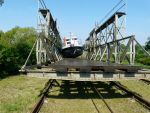 The passage through the slipways is one of the most exciting moments of our cruise, we will devote to their passage from two to three hours. It can take even longer if we hit the ships of the white fleet, they have priority on inclines, and they always sail in groups. The main and most important element of the slipway is the two transport trolleys, placed on two parallel tracks. One at the top, the other at the bottom. They are dragged using steel ropes and pass halfway along the length of the ramp. On these trolleys are transported ships, yachts and everything else what floats.
The passage through the slipways is one of the most exciting moments of our cruise, we will devote to their passage from two to three hours. It can take even longer if we hit the ships of the white fleet, they have priority on inclines, and they always sail in groups. The main and most important element of the slipway is the two transport trolleys, placed on two parallel tracks. One at the top, the other at the bottom. They are dragged using steel ropes and pass halfway along the length of the ramp. On these trolleys are transported ships, yachts and everything else what floats. 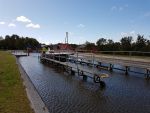 The trolleys are made of flat bars, angles, trusses and other metal body, wide at the top, narrowing downwards (after renovation everything has been covered with wood, hopefully enough). The bottom is wooden beams, stacked every 60-80cm (two of them, in the middle of the car stick above the rest) and it is on them that the boats sit on them. The trolleys are longer than we initially think (like an iceberg, the greater part of them is in the water when we see them for the first time), platform is about 1.5m longer in front and back from the bridge we see. You can push up to three medium units on trolley (our yachts are quite big so they will be on the cart or with something smaller). Our yachts are best positioned at the end so that the stern with the engine protrudes beyond the trolley, we have one hundred percent certainty that we will not damage the engine. Before the first ramp we have to approach the quay and arrange the formalities (we pay for all the slipways at the first operator), then it is worth to look at how other crews are handling the ramp. The operation is not complicated in itself, but there are a few things that can surprise us, one of them is the side current on the approach (water outlets driving the ramps). On each of the carts is a gong with a hammer, which we inform about its readiness to ride and manual safety brake (do not hesitate to use it if something goes wrong).
The trolleys are made of flat bars, angles, trusses and other metal body, wide at the top, narrowing downwards (after renovation everything has been covered with wood, hopefully enough). The bottom is wooden beams, stacked every 60-80cm (two of them, in the middle of the car stick above the rest) and it is on them that the boats sit on them. The trolleys are longer than we initially think (like an iceberg, the greater part of them is in the water when we see them for the first time), platform is about 1.5m longer in front and back from the bridge we see. You can push up to three medium units on trolley (our yachts are quite big so they will be on the cart or with something smaller). Our yachts are best positioned at the end so that the stern with the engine protrudes beyond the trolley, we have one hundred percent certainty that we will not damage the engine. Before the first ramp we have to approach the quay and arrange the formalities (we pay for all the slipways at the first operator), then it is worth to look at how other crews are handling the ramp. The operation is not complicated in itself, but there are a few things that can surprise us, one of them is the side current on the approach (water outlets driving the ramps). On each of the carts is a gong with a hammer, which we inform about its readiness to ride and manual safety brake (do not hesitate to use it if something goes wrong).
The transition of the ramp is maneuvers like any other, so we are doing plan A and plan B, we explain to the crew what and how we will do, we set her duties, we prepare the yacht (fenders, moorings, etc.). On the trolley we influence with minimal controllable speed (the bow thruster will be useful again), when we are between piers, we send landing on the left or right bridge with ropes (we do not jump with ropes, it is better to leave without waiting for another crew member to give it to us). The crew remained on the side of the yacht repels the boat from the construction of the trolley. Two ropes, mounted on the bow and stern will now be springs (so we call the ropes that look from the bow, towards the stern - the forward spur and from the stern towards the bow - stern springs), such rope positioning will allow better control of the yacht when the trolley moves. Working on the springs is quite an important element of the entire operation, when the trolley will move, the yacht will be for a while but the contra spout will pull it forward (also work spigot so that the boat does not go too far). Until the yacht settles on the platform, it will fly a bit, all its movements are corrected with springs. Before informing the operator about our readiness, we absolutely turn off the engine (it is cooled with water, and after all we will be driving on the grass). We turn it on only when the boat submerges again in the water. The yacht goes with the trolley, and after a while, when the trolley begins to emerge from the water, slowly settles on the trolley - people on the platform must then quickly release the springs. If they do it too fast - the yacht will "run away" and it may fall on other yachts, if too slow - we will hang on the ropes. The remaining part of the crew stays on the yacht and will push the yacht away from the side walls of the trolley, so that it settles down on the bottom, it is relatively evenly based. We remember that part of the metal reinforcements of the side walls is directed diagonally towards the center, and this is visible only when the trolley emerges. Synchronization of these activities (using ropes from the slipway platform and pushing the yacht away from the side wall of the trolley) requires some practice. This moment is the most stressful and nervous moment of the entire crossing, especially if we sail for the first time. When the boat is on the trolley (from one meter to three below the level when you enter the trolley), we just go, it takes 15 to 20 minutes. Before diving the cart again, we have to skillfully and sensitively work on the springs, so that the yacht has a similar speed to the trolley. When the car stops, we turn on the engine and we leave, five times. At the last we are already experts.
SLUICES
 Locking is also an exciting moment and like all maneuvers requires good preparation. The Nogat sluices are much larger than the locks on the Elbląg Canal and they should not cause any problems if we apply a few rules that govern this operation. We influence only after permission from the mucus and we strictly follow its instructions, we catch the spiders on the poles on the walls of the locks. The yacht will go down or up, fixing the springs permanently will cause the yacht to either go away from the sluice wall when the water level rises or damage cleats when the water level drops. The experience of working on springs gained on ramps is definitely useful now. Water movement in the airlock may cause a current that will start the yacht, but the spiders and fenders should do the trick. The engine in the lock can go idle.
Locking is also an exciting moment and like all maneuvers requires good preparation. The Nogat sluices are much larger than the locks on the Elbląg Canal and they should not cause any problems if we apply a few rules that govern this operation. We influence only after permission from the mucus and we strictly follow its instructions, we catch the spiders on the poles on the walls of the locks. The yacht will go down or up, fixing the springs permanently will cause the yacht to either go away from the sluice wall when the water level rises or damage cleats when the water level drops. The experience of working on springs gained on ramps is definitely useful now. Water movement in the airlock may cause a current that will start the yacht, but the spiders and fenders should do the trick. The engine in the lock can go idle.
ANCHORING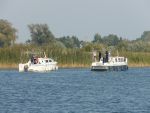 Anchoring is probably the least stressful maneuver, usually we have a lot of space around, but choose places sheltered, for example, bays on the lakes and with the appropriate depth (for this purpose, an echo sounder mounted on our boats will be useful). Remember that the anchor strength depends on the depth and length of the anchor rope (preferably as much as possible on the bottom). We do not recommend overnighting at the anchor, after all we will not keep the night anchor watch, stay better in places designated for that.
Anchoring is probably the least stressful maneuver, usually we have a lot of space around, but choose places sheltered, for example, bays on the lakes and with the appropriate depth (for this purpose, an echo sounder mounted on our boats will be useful). Remember that the anchor strength depends on the depth and length of the anchor rope (preferably as much as possible on the bottom). We do not recommend overnighting at the anchor, after all we will not keep the night anchor watch, stay better in places designated for that.
Once we have chosen the anchoring point, we approach the wind at the minimum speed, stop the yacht and put on the bow anchor, if the wind is too weak and the yacht does not turn back, we help with the engine, loosening the anchor rope at that time. We give her as much as we need, the more the better, but remembering that the wind can change and turn the yacht. The circulation radius is the length of the rope issued plus the length of the yacht, in this area we should not have other yachts or obstacles (shoals, reeds, etc.). The King of Life is equipped with an electric anchor lift, remember that this system is just as powerful as a bow thruster.
RIGHT OF WAY
No obligation to have a license does not absolve anyone from the obligation to know the rules of the right of way. I will try to present them in the most simplified and easy to remember way. Below are a few definitions:
Small ship - means a ship whose length of the hull is less than 20 m; small ships do not include, irrespective of their dimensions, ships authorized to carry more than 12 passengers, or those that are ferries or operate a set made up of ships that are not small ships or are suitable for driving a set - practically all types of tugboats and pushers.
Power-driven vessel - means any ship launched in motion by a machine, except for vessels whose machinery is used only for small displacements or for enhanced handling of the ship.
Sailing vessel - a ship moving exclusively with the help of sails; a ship operating simultaneously with the aid of sails and a mechanical propulsion device is considered to be a power-driven vessel. But if a sailing vessel will, for example, help himself with a bow thruster while turning, he will still be a sailing vessel - the bow thruster is used in this case only to increase the ship's handling.
The rules of the right of way
Let's start with ships moving at high speed. For such, in accordance with the law are considered units whose speed at a given moment exceeds 40 km / h. Such vessels should leave other ships a reservoir that will provide them with the opportunity to preserve the course and be free to maneuver. High-speed ships can not demand that other ships give way.
Small ships should give way to other ships. Small ships, mainly us, give way to all ships larger than 20 m, passenger ships, tugs, pushers, towed sets, etc. Often this provision is simplified and translated in such a way that we give way to those who are on the water at work . The exception to this recipe is the situation when the "big" ship develops high speed, and we do not. Then there is no priority.
Rules applicable between small ships
There is a "hierarchy of privileges" between small ships: powered ships (ie our housebots) give way to all other ships, i.e. sailing yachts or, for example, kayaks and rowing boats. Ships that are not mechanically propelled or sailed, i.e. a previously mentioned kayak, give way to ships with a sail propulsion. At the moment when two ships with mechanical propulsion meet on the collision course - the following rules apply to them: it can be said that the "right-hand" rule applies here, the right-hand ship has priority. When we leave the road, we avoid crossing the course in front of the bow - it is best to follow the stern of the ship, to which we give way (ie we turn right). If two powered vessels are going straight on each other, both should change course to the right.
How to behave when giving up priority?
Of course, if we have to give way to someone else, if possible, we avoid crossing the course in front of the bow. Our actions should be determined enough to be noticed from the other unit. The course or speed should be clearly changed.
How to behave when we have priority?
If we are in a situation in which we have priority, it is our duty to keep the course and speed. If, however, the ship does not give way to us, we should make a maneuver to avoid collision. Regulations do not regulate how such a maneuver should look, but it is advisable to turn the circulation to the right to avoid the situation when we change course to the left and the other yacht to the right (because it should) and the dangerous situation is ready.
Overtaking
Of course, it is allowed, provided that the forerunner finds that it will not pose a threat. The overtaken vessel should, as far as possible, facilitate the overtaking maneuver. However, the easiest way to explain this rule is that it is preceded by the pre-emptive one.
If a motor-powered boat overtakes another motorboat, we should do it from its port side (around the world on the waterways there is a right-hand traffic), but if the width of the trail is sufficient, we can overtake on the right.
COMMON SENSE
Of course, you should show common sense, which is called good sailing practice, outside of the regulations. When we see any training, whether for regattas or sailing or motorboat training, we try not to interrupt. It is easy to recognize, because usually the boats involved in the training revolve around some buoys, and the training yachts repeat the same maneuvers, eg they practice the "man overboard" maneuver. We also apply the principle of limited trust and execute each maneuver in advance so that the other entity will know our intentions as soon as possible.
A STEP BY STEP CRUISE
Holidays on a yacht is a great way to spend holidays with family or friends. The availability of this type of tourism has increased significantly in the last few years, today even people who have nothing to do with water before can charters and go on a cruise. A walking yacht is a camper on the water, like a hotel and yet something completely different. To help you find your place in the water world, we created the guide STEP BY STEP. Despite all efforts, something may have escaped or we have not dispelled all your doubts, in which case we ask for a phone call, we will try to help.
SAILING WITHOUT LICENSE - WHERE AND ON WHICH RULES
The Act of 25 June 2010 on sport (Journal of Laws of 2010, No. 127, item 857) in Chapter 11 included a number of changes to the previously applicable provisions, including the Act of 21 December 2000 on inland navigation (Journal of Laws of 2006 No. 123, item 857, as amended). The most important change affecting sports and recreation on motor and sailing boats in inland waterway traffic is the introduction of entries specifying the scope of rights required to operate boats with specific parameters. And yes:
"Art. 37a.
It does not require a qualifying document to practice water tourism on motor yachts with an engine power of up to 75 kW and a hull length of up to 13 m, whose maximum speed is limited to 15 km / h. In the case of yachts intended for rent, water tourism requires a boat safety training on the water. This requirement does not apply to persons having qualifications in the field of maritime or inland navigation specified in the regulations issued on the basis of para. 5. "
Remember that the Vistula Lagoon is the internal sea waters and the yachts on this reservoir are obliged to have at least a motorboat helmsman's license.
FEES
In Poland, swimming on inland waters for tourism and recreation is free. The costs you incur are the operating costs of the yacht: fuel, water, electricity, gas, disposal of waste. In addition, the costs associated with sluicing, slipway (tens of zlotys), stops in marinas (depending on the marina standard and availability of services: from several to several dozen zlotys per night). Many jetties or marinas (eg on Jeziorak) are free, otherwise you can stay in the wild. All these additional costs should not exceed 500 PLN per week cruise.
ONE-WAY TRIP
As a rule, we take over and return the yacht at the home port, plan a cruise so that it is possible. However, we are flexible and it is possible to pass a yacht in a different place, however, you must inform us in advance and remember that this may create additional costs (someone has to take the yacht to the home port). It is also possible to get along with two crews and take over the yacht on the route. We also need to know this beforehand, and such transfer must take place in the presence of the shipowner's representative.
BEGINNING AND THE END OF THE CRUISE
Holidays on the yacht usually last for a week or two weeks in the high season (July, August), start on Saturday at 1800, and end on Saturday the next at 1100. Other hours to be agreed. In the off-season, shorter trips are possible, unfortunately you should expect a price increase (3 days + 25%, 4 to 5 days + 20%). Yachts are chartered for days, not nights, eg a weekend is three days of charter.
INSURANCE
The price of charter includes liability insurance, CASCO and NNW. The General Terms and Conditions of Insurance are always at your disposal and we remind you to comply with them. The yacht is not a cheap toy and it should be remembered that damages, eg caused by alcohol, will not be settled with insurance, so they can be charged.
ARRIVAL TO THE HOME PORT
As we mentioned, we are waiting for you from 1800 on the first day of charter. In the price of a charter, you have a stop at our port, on the day the yacht is delivered and returned. Our home port is Przystań na Wyspie in Miłomłyn, ul. Market 3A. Miłomłyn is located by the national seven and the marina is in the city center, so getting to us should not be embarrassing.
FORMALITIES
We are here to help. All the formalities related to your cruise (deposit payment, additional arrangements, eg transport of a car on the One-way voyage) will be settled within a dozen or so minutes. Then you will receive up-to-date information on the selected route and we will deal with the transfer of the yacht.
ACTUATION OF THE YACHT
It's time to get on board. Before you unload your luggage, we will show you how it works and answer all your questions. Together we will check the condition of the equipment, we advise you to familiarize yourself with it earlier, it will allow you to avoid picking up things from home that will be at your disposal. This part will end with the signing of the transfer and acceptance protocol. This document will list all equipment along with its valuation. Please remember that this document will be useful when you pass the yacht after the cruise.
TRAINING - SAILING BY YACHT
It is worth having a short barge maneuvering training - it is included in the price for everyone without a patent. We recommend the use of the training to everyone, even people with motorboating experience. A few maneuvers on the water under the supervision of an experienced skipper will help "feel" the barge and lead it probably from the beginning of the cruise. Our yachts are powered by modern SUZUKI trailer engines, with tie-rods (thanks to this we have obtained a few additional "horse" powers), maneuvers in ports will also facilitate streamers.
BAIL FOR A YACHT
On the day of embarkation, you pay a deposit for entrusted equipment in the amount of PLN 1,000. Any losses incurred on the yacht, claims of third parties (not covered by insurance), delayed return of the yacht to the home port, departure of an unclassified yacht, etc. are covered from the deposit. If everything is in good order, you receive the entire amount.
NAVIGATION
When planning a trip, the number of days needed to cover the proposed routes can be determined based on the assumption that we swim about 4-5 hours a day at a safe speed of 8-10 km / h. (crossing a day from 30 to 50km, it causes that we have time to use other attractions on the trail). Remember that the current on the Vistula is about 3km / hour, so it can be lengthened or shortened, additional time is also the passage of sluices and slipways, drawbridges are opened at specific times (all information regarding prices and working hours you will receive on embarkation). The region and its water routes are very diverse in terms of difficulty. At the Loop and Canal (including the lakes) everyone should manage, but the lagoon is a reservoir for more experienced water sportsmen. Nevertheless, the weather should be checked as often as possible and its variability taken into account during the voyage. On the yachts there are electronic and paper maps, routes and guides that will help you navigate the region.
MOORING
During a yacht cruise, you can stay practically anywhere, anytime of the day (we only swim at day time) in specially adapted marinas or on any shore, in the wild, an exception are places where there is a sign NO MESSAGE and locks and bridges, Also, do not stop at the Elbląg Canal outside the designated places due to the small width of the canal, on the Vistula outside the marinas in Tczew. On the Lagoon, let's also choose only marinas (the ideal places for mooring in the wild will be bays and islands of lakes on the trail). The list of paid and free marinas can be found on our yachts.
LOCKS AND SLIPWAYS
Transitions through hydrotechnical structures such as sluices and slipways belong to the most exciting moments of the cruise. During sluicing we are obliged to strictly execute all commands given by the locks, similarly on the slipways. The locks are usually serviced from 0900 to 1900 (a list of working hours and prices can be found on the yacht). We also offer you extended training, including the passage of the incline with our skipper.
REPAIRS, ROUTE MAINTENANCE AND WATER TRAILERS
Both sluices and waterways sometimes require repairs and renovations, which is why - mainly outside the summer seasons - they can be closed. The exact dates of their discontinuation are announced in the RZGW navigational messages, we follow them and we will keep you informed about them. Nevertheless, before the cruise, we advise you to check whether the implementation of your chosen route will be possible. Miłomłyn is in such a place that you have a choice of several routes and each of them is interesting.
COMFORT AND SAFETY
While sailing a boat, you are close to nature, away from the hustle and bustle of the city, but almost every day you can easily replenish your supplies, although the yachts were built to have a few days of autonomy. Our units - regardless of which one you choose - have been designed to provide the crew with maximum comfort. Each tourist barge has a mess, comfortable berths, heating, chemical or marine toilet, after an eventful day you can take a warm shower, in the evenings a radio, TV, games or books will come in handy. Space on the barge is necessarily limited, but since the most important place on the deck is the mess, the constructors made sure that it was as wide as possible. Sleeping cabins are not large, but in addition to berths, there are spacious cabinets. Each crew member receives a pillow (pillowcases, sheets and towels are at your discretion, although you can rent them). Yachts have an electrical installation of 12V (230V, only in the port after connecting battery charging), but we provide various types of adapters to facilitate. You use your own devices.
Our yachts are equipped with life-saving appliances, they have fire extinguishers. All barges are designed to minimize any danger associated with swimming - the decks are flat and surrounded by railings. The shape of the hull and the nature of the routes visited make it not "buoy" when swimming and that is why swimming is very safe (remember that the Vistula Lagoon is internal sea waters and the weather can play a trick, high tide and strong wind can effectively make sailing difficult). If there is a child on board, it is obliged to wear a life jacket adapted to its weight.
GALLEY
Holidays on the yacht, a great opportunity to taste local dishes, a list of recommended pubs you will find on the side (in some you will get special discounts). Kitchen equipment, although limited, allows you to prepare the most sophisticated dishes - there is everything that is useful for cooking and serving meals (the King of Life also has an oven). Our units have also been equipped with small refrigerators at 12V or 230V, this solution makes it possible to use different energy sources depending on your needs (we suggest you go on 230V as soon as you connect to the "land" current). The number of dishes in the tableware always corresponds to the maximum number of people who can swim on the yacht. Remember, however, that washing the dishes should only take place in designated places in the marinas. On the yacht, we can only rinse them, the sinks have a direct exit overboard, so using any home chemistry is forbidden. Unfortunately, this also applies to the shower, direct exit overboard, eliminates the use of any liquid for baths, soaps, etc., you must have enough hot water.
BIKES
We've made sure that our yachts have space for several bikes. Excursions on perfect bikes will diversify your holiday. On many routes, very interesting places are located a few kilometers from the route of our sailing. We will reach the places where it would be difficult to reach by foot, we will reach it several times faster. We also have bicycles for children.
SWIMMING
There are usually a lot of places suitable for bathing on the route, but bathing suits are also useful on sunny days when the crew is sunbathing while lying on the deck. Remember that baths in non-guarded places are allowed in Poland but they carry many risks. We suggest choosing places surrounded by lifeguards. Remember that the vests provided on the yacht are life-saving appliances and are used for this purpose. There are several inflatable toys on each of the yachts, which will surely cheer up our little ones while swimming in the water.
FISHING
Polish fishing regulations are rather skimpy but it all boils down to buying the right permit. The yacht has simple fishing equipment and a list of necessary permits. Among friends, we have avid anglers who will surely help organize appropriate papers if we find out about your needs in advance.
BONFIRE
The Polish law is quite clear when it comes to lighting bonfires, it can only be done in designated places, which are not lacking on the trail. One of the additional services is a focal set, ie a 100l tree bag and a cauldron or a barbecue grill. In a free recipe for tasty pies from this cauldron. Please do not use as a seat the mattresses and life jackets, for this purpose are used mats, which are equipped with each of the yachts.
PURCHASES AND STOCKS
The provisions can be completed in almost every town located on the route. We recommend large and bulky purchases before the cruise, using a car for this purpose. In the range of additional services, we also offer an arrangement of the yacht according to your list, we will also deliver the necessary products on the trail, however, it is associated with additional costs. The yacht for your arrival is comprehensively checked, and supplies (water, fuel, electricity, gas) topped up (in the same condition must be passed, after choosing a voluntary service fee, we take it on yourself, you will only be settled with fuel). With water, you should not have major problems, almost every marina is accessible to it. The fuel is a little worse, but you will find the yacht on the yacht, a list of petrol stations closest to the trail and a portable canister (which is also full when you sign on, if it is your request we will provide fuel for the route). The engine consumes about 2 to 3l of fuel per hour, as it is easy to calculate when swimming 5 hours a day, 100l is the week of swimming. Let's not allow ourselves to float on the fumes, we recommend keeping a 25% minimum.
The batteries are also charged and will be enough for a few days of the cruise, the more so that in addition to land charging they also have charging from the engine and solar panel. The gas cylinder is a typical 11kg cylinder from which the stove and heating are "driven", normal operation allows sailing a week on one cylinder.
In stock management, you can use the "ON BOARD MONITOR" installed by our company AMPERFLEX, which not only shows the current state of inventory, but also counts the current and daily consumption of electricity and water. It will show battery charging speed, etc., in other words an on-board computer that is designed to facilitate cruise planning.
TOURIST ATTRACTIONS
You can find most of the useful information about the places you pass on the route in the guides that are on each of our yachts. Swimming on a barge does not mean that you have to limit yourself to the closest neighborhood of the waterway. It is worth walking, cycling or using a taxi to visit interesting places nearby - take a walk through the streets of passing towns or villages, visit museums, old towns or local pubs.
ANIMALS ON YACHT
Enjoy the cruise of all owners of pet animals with pets (however, it is associated with an additional fee), but please remember that it is the owner's responsibility to care. Make sure that the animals do not jump into the bunk and lie in the bedding, and that they should be especially careful for safety reasons, especially during sluicing.
FAILURES
Failures happen fortunately extremely rarely. In this situation, it is necessary to call the Owner. We will try to remove the fault as soon as possible, so that you can continue your cruise without any problems. Try to follow the instructions for the yacht and devices installed on it, sometimes the fault is not a fault, but not following the manufacturer's instructions. There is a short guide on each of the yachts, what and how to check to facilitate the diagnosis.
WEATHER
The weather, as my professor of meteorology used to say, is something that humanity can change faster than predict. True or not, we do not judge it. It is true that today's weather forecasts are quite accurate, and these 24Hs work well at almost 90%. So please, monitor the weather all the time, the more so because the availability is huge. In the LINKS tab you will find redirects to pages with the most accurate, in our opinion, forecasts. As for the cruise itself, of course, swimming in the sun is the most desirable thing. Nevertheless, even on rainy days, sailing has its charm. On our yachts you will find TV, games and books, which hopefully will help you survive the days with weaker weather.
ECOLOGY
We are all responsible for what our world looks like and will look like. Our ecological awareness is already big enough that we will not write about how the rubbish and sewage destroy our environment. Yacht vacations, however, are specific and one should follow a few simple rules. We store garbage in large, strong bags and we only carry in places designated for this. We do not use any household chemicals to wash the yacht, dishes or baths, we can use these benefits in marinas. We are all human, so physiological matters should not be alien to us. WC on yachts should be used only when we have to, use these shrines in marinas and marinas. Chemical toilet should be emptied and washed as often as possible in places designated for this purpose. Faecal tank, although large (600l) must also be emptied one day, we can do it only in a few places, certainly in Elbląg, Iława and Gdańsk. In both cases we use special toilet paper, which easily dissolves in water, such paper will be on the yacht. We do not throw anything into the toilet except with this paper. Instructions on how to use WC devices can be found on yachts.
WHAT TO TAKE ON THE YACHT
Before arriving, it is worth getting acquainted with the list of equipment of each yacht, it will help you decide what to take and minimize your luggage, because remember that the yacht is not made of rubber and the fewer things we take the more space for us. However, there is a minimum that should be remembered:
• rainwear (raincoat)
• warm sweater, blouse or fleece
• footwear on a soft rubber sole, flip-flops
• tracksuit
• pants, non-binding movements, preferably suits
• warm sweatshirt or flannel shirt
• woolen hat and headgear for sunny days
• clothes for hot weather (T-shirts, shorts)
• toiletries, cream with UV filter, bath towels
• Sunglasses
• school ID card for children and identity card for yourself
There are first aid kits on the yachts, but the medicines you need are always taken with you. Pack it best for a soft travel bag or a sailing bag. If it happens that you have forgotten something from home, we will try to help you.
CLEANING THE YACHT AFTER A CRUISE
The barge after the voyage must be cleaned up - its cleanliness can not be lower than at the time of embarkation. Chemical toilet empty and washed, empty faeces tank, and water and solid fuel tanks. You can clean it yourself or order for a fee, cleaning service so-called. service fee, which will cause all of this work to fall on us. Remember that even if you choose the option of paying for cleaning, leave one after the other:
• dishes washed and set
• empty trash can and fridge
• empty and clean drawers and cabinets
• sent berths
Remember that the more we care about the equipment during the voyage, the less work awaits us after it. Let's not take the mattresses outside, do not sit on life jackets near the campfire etc.
EXAMPLE OF ROUTES
Miłomłyn is located in a place from which several water routes spread. Each of them has a different degree of difficulty, but each is interesting and worth crossing. Several hundred kilometers of canals, rivers and lakes cause that the return never gets boring, you can always choose a different direction of the cruise. We are here to advise, help and tell you about routes. Below are a few of them:
Kanał Iławski, Miłomłyński, Ostródzki + lakes ("for amateurs" :-))
1. Cruise perfect for 7 days:
Miłomłyn - Siemiany - Zalewo - Iława - Ostróda - Miłomłyn
• Number of drawbridges on the route - 0
• Number of inclines on the route - 0
• Number of locks on the route - 2 - on the route to Ostróda
On the route: j. Jeziorak, j. Ewingi, j. Drwęckie
A route for less experienced water sportsmen, no slipways, only two locks on the route from Miłomłyn to Drwęckie. Periodic cleaning of the screw and cooling control of the motor are necessary. Overnight in marinas along the route or wild on the lakes. Large and well-equipped marinas can be found in Iława, Siemiany, Zalew and Ostróda. On Jeziorak there are several free marinas with a toilet, a big trash bag and a place for a bonfire. From Jeziorak to Drwęckie we sail through Miłomłyn, remember that you have free parking, water and electricity.
2. The perfect trip for 3 - 4 days:
Miłomłyn - Iława - Miłomłyn or Miłomłyn - Ostróda - Miłomłyn The routes are short but pleasant, to visit the longest lake in Poland. The locks only on the route to Ostróda.
The Elbląg Canal + the Żuławy Loop
1. Cruise perfect for 7 days (the longer the better):
Miłomłyn - Elbląg - Malbork - Tczew - Biała Góra - Żuławki / Drewnica - Osłonka - Elbląg - Buczyniec - Miłomłyn
• Number of drawbridges on the route - 4
• Number of inclines on the route - 5
• Number of locks on the route - 5
On the route: Ilińsk, j. Ruda Woda, j. Druzno, Elbląg Canal with ramps, Jagieloński Channel, rz. Nogat with locks, rz Wisła, rz. Szkarpawa.
An intense getaway for more experienced water enthusiasts allowing you to visit the wonder of hydrotechnics. Staying overnight in well-equipped marinas, including Elbląg, Malbork, Tczew, Osłonce or wild in lake bays. Necessary periodic cleaning of the screw and control of the engine cooling. It is possible to do in 7 days but the longer the better. When weather conditions deteriorate, Wisła becomes undershooted and harder to navigate. it can also be temporarily excluded from shipping due to low water levels. Szkarpawa and Nogat are lazy flowing rivers overcome without problems even by inexperienced water sportsmen.
2. Cruise perfect for 3 days:
Miłomłyn - Elbląg - Miłomłyn (as we have another day worth visiting Malbork)
A short but educational cruise. On the route, a miracle of hydrotechnics - five historic slipways, and a waterfowl reserve, and not only at Drużno. Drawbridge in Elbląg and two locks if you go to Malbork. Free stop at the Elbląg Boulevards in the heart of the old town.
Elbląski Canal + the Vistula Lagoon (only with a patent)
1. Cruise perfect for 7 days:
Miłomłyn - Elbląg - Sztutowo - Krynica Morska - Frombork - Elbląg - Buczyniec - Miłomłyn
• Number of drawbridges on the route - 3
• Number of inclines on the route - 5
• Number of locks on the route: 0
On the route: Elbląg Canal with the lakes of Ilińsk, Ruda Woda, Druzno; n. Elbląg, the Vistula Lagoon.
Cruise only for water sportsmen with a patent (the Vistula Lagoon is the internal sea water) and only in good weather (going to the Lagoon). Deterioration of conditions makes the Lagoon become swayed and harder to navigate. The lagoon is a shallow basin with rapidly changing weather. Several modern marinas are waiting for water sportsmen: Sztutowo, Kąty Rybackie, Krynica Morska, and the city of Nicolaus Copernicus - Frombork.
In the waters of Gdansk
1. Cruise perfect for 7 days:
Miłomłyn - Elbląg - Drewnica - Gdańsk - Gdańsk - Gdańsk - Rybina - Elbląg - Miłomłyn
• Number of drawbridges on the route - 5
• Number of inclines on the route - 5
• Number of locks on the route - 2
On the route: Elbląg Canal with lakes, Jagiellonian Canal, Szkarpawa, Wisła, Martwa Wisła, Motława.
Best trip, after two / three days of peaceful sailing we are in Gdansk, marinas in the very center of the old town cause that everything we want we have at our fingertips. We will book a few days to explore the attractions of the Tri-City, a great alternative for hotels, guest houses, etc.








